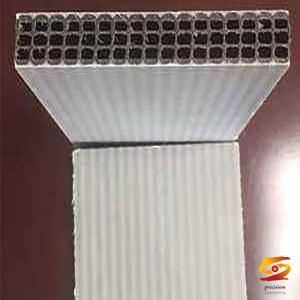Solve the common problems in PVC foam board extrusion
Solve the common problems in PVC foam board extrusionIn the extrusion process of PVC foamed sheet, the problems encountered can be classified into four categories: stability, melt strength, lubrication and dispersion. These four kinds of problems, especially the first three, will restrict and cross influence each other. From the surface phenomenon, sometimes the stability is not enough, which will affect the whole board surface. The board surface turns yellow and the foam board is brittle.
Lack of melt strength will result in large bubble holes and long longitudinal cut surface bubbles. The most direct way to judge whether the melt strength is insufficient is to press the plate wrapped on the middle roll with fingers behind the three rolls. When the melt strength is good, the elasticity can be felt. If it is difficult to spring up after pressing, the melt strength is poor. It is difficult to judge whether the temperature is reasonable because of the large difference between screw structure and cooling mode. Generally speaking, in the allowable load of extruder, the temperature of zone 3-5 is better than that of zone 3-5.
Lubricants are divided into external lubricants and internal lubricants. External lubricants are conducive to demoulding and good for the surface finish of the plate. There is too little external sliding. The temperature in zone 5 of the extruder is not easy to control and it is easy to heat up. This will cause high temperature of the confluence core, blisters, blisters, yellowing and other problems in the middle of the plate, and the surface of the plate is not smooth. There is too much external sliding and precipitation will become serious, which is manifested in the knots in the mold Scale and the precipitation of the board surface sliding will also show some individual phenomena moving back and forth on the board surface irregularly. Internal sliding is beneficial to plasticization and melt fluidity. If the internal sliding is insufficient, it is difficult to control the thickness of the plate surface, which shows that the thickness in the middle of the plate is thin on both sides; if there is more internal sliding, it is easy to have high temperature of the confluence core. Poor dispersion will lead to the phenomenon of unsmooth plate surface.
Process temperature control: the four problems mentioned above are fundamental, fundamental and deep-seated. Compared with the above four problems, the process temperature control is much more intuitive, it is a surface problem, but the poor temperature control will lead to the emergence of fundamental problems. If the processing temperature is increased, the material stability time will be reduced and stability problems will occur; the original lubrication balance will be broken, which is generally manifested as insufficient external lubrication, especially in the later stage, the amount of external lubrication needs to be increased; if the temperature is increased, the melt strength will also be reduced, the bubble holes of foamed sheet will be increased, the number of bubble holes will be reduced, and the sheet will be brittle and easy to fracture; if the temperature is increased, the melting will be reduced The bulk strength will also reduce the viscosity of the melt, and the viscosity will reduce the shear dispersion ability. For the screw with weak dispersion ability, sometimes the dispersion will be uneven.
If you want to know more about it please do not hesitate to
contact me. WhatsApp:+86-15966835076.









